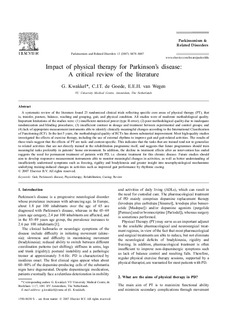| dc.contributor.author | Kwakkel, G. | |
| dc.contributor.author | de Goede, C.J. | |
| dc.contributor.author | van Wegen, E.E. | |
| dc.date.accessioned | 2018-04-20T10:57:50Z | |
| dc.date.available | 2018-04-20T10:57:50Z | |
| dc.date.issued | 2007 | |
| dc.identifier.citation | Kwakkel, G., de Goede, C. J., & van Wegen, E. E. (2007). Impact of physical therapy for Parkinson's disease: a critical review of the literature. Parkinsonism Relat Disord, 13 Suppl 3, S478-487. | nb_NO |
| dc.identifier.uri | http://hdl.handle.net/11250/2495277 | |
| dc.description.abstract | A systematic review of the literature found 23 randomized clinical trials reflecting specific core areas of physical therapy (PT), that is, transfer, posture, balance, reaching and grasping, gait, and physical condition. All studies were of moderate methodological quality. Important limitations of the studies were: (1) insufficient statistical power (type II error); (2) poor methodological quality due to inadequate randomization and blinding procedures; (3) insufficient contrast in dosage and treatment between experimental and control groups; and (4) lack of appropriate measurement instruments able to identify clinically meaningful changes according to the International Classification of Functioning (ICF). In the last 5 years, the methodological quality of RCTs has shown substantial improvement. Most high-quality studies investigated the effects of exercise therapy, including the use of external rhythms to improve gait and gait-related activities. The results of these trials suggest that the effects of PT are task- and context-specific. This indicates that the tasks that are trained tend not to generalize to related activities that are not directly trained in the rehabilitation programme itself, and suggests that future programmes should train meaningful tasks preferably in patients' home environment. In addition, the decline in treatment effects after an intervention has ended suggests the need for permanent treatment of patients with PD, i.e. chronic treatment for this chronic disease. Future studies should aim to develop responsive measurement instruments able to monitor meaningful changes in activities, as well as better understanding of insufficiently understood symptoms such as freezing, rigidity and bradykinesia and greater insight into neurophysiological mechanisms underlying training-induced changes in activities such as improved gait performance by rhythmic cueing. | nb_NO |
| dc.publisher | Parkinsonism & Related Disorders | nb_NO |
| dc.subject | Gait | nb_NO |
| dc.subject | Parkinson's disease | nb_NO |
| dc.subject | physiotherapy | nb_NO |
| dc.subject | rehabilitation | nb_NO |
| dc.subject | cueing | nb_NO |
| dc.subject | review | nb_NO |
| dc.title | Impact of physical therapy for Parkinson's disease: a critical review of the literature | nb_NO |
| dc.type | Journal article | nb_NO |
| dc.source.pagenumber | 478-487 | nb_NO |
| dc.source.volume | 13 | nb_NO |
| dc.source.journal | Parkinsonism & Related Disorders | nb_NO |
| dc.source.issue | Suppl. 3 | nb_NO |
| dc.identifier.doi | 10.1016/s1353-8020(08)70053-1 | |
| dc.description.localcode | måsjekkes | |
